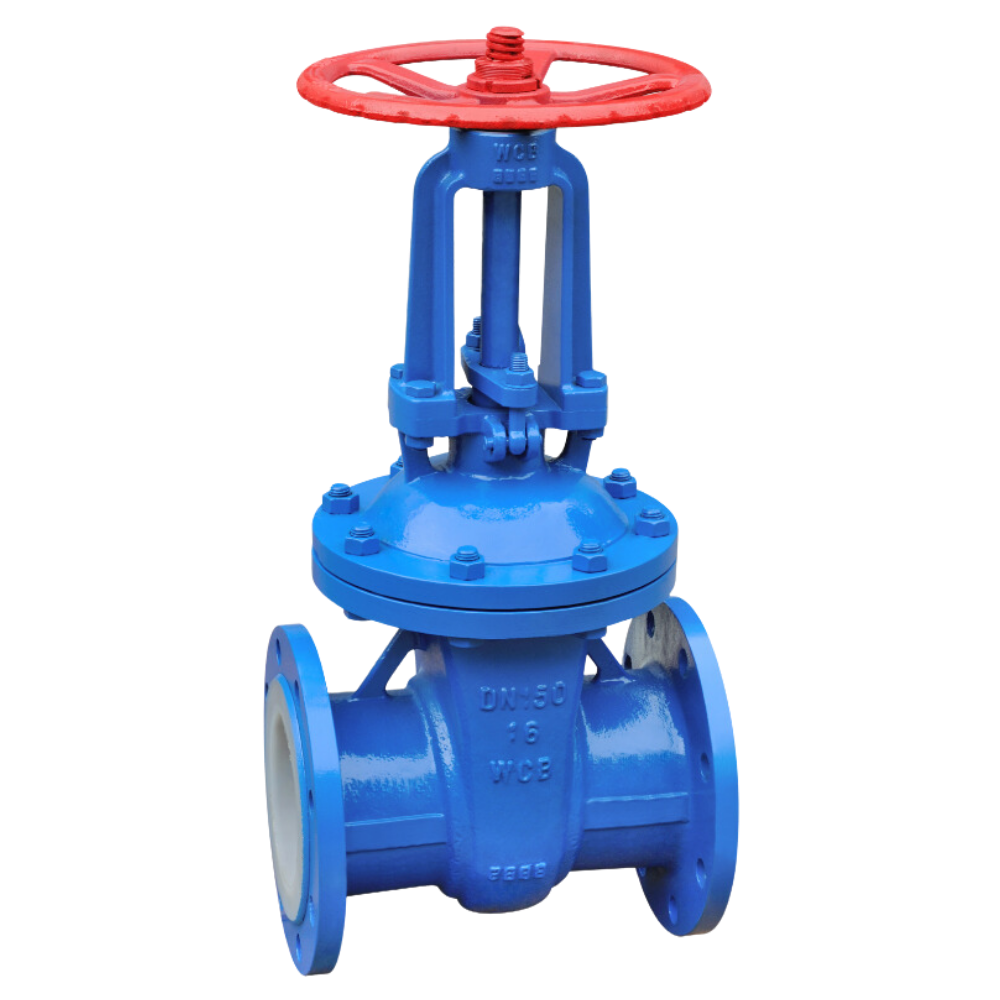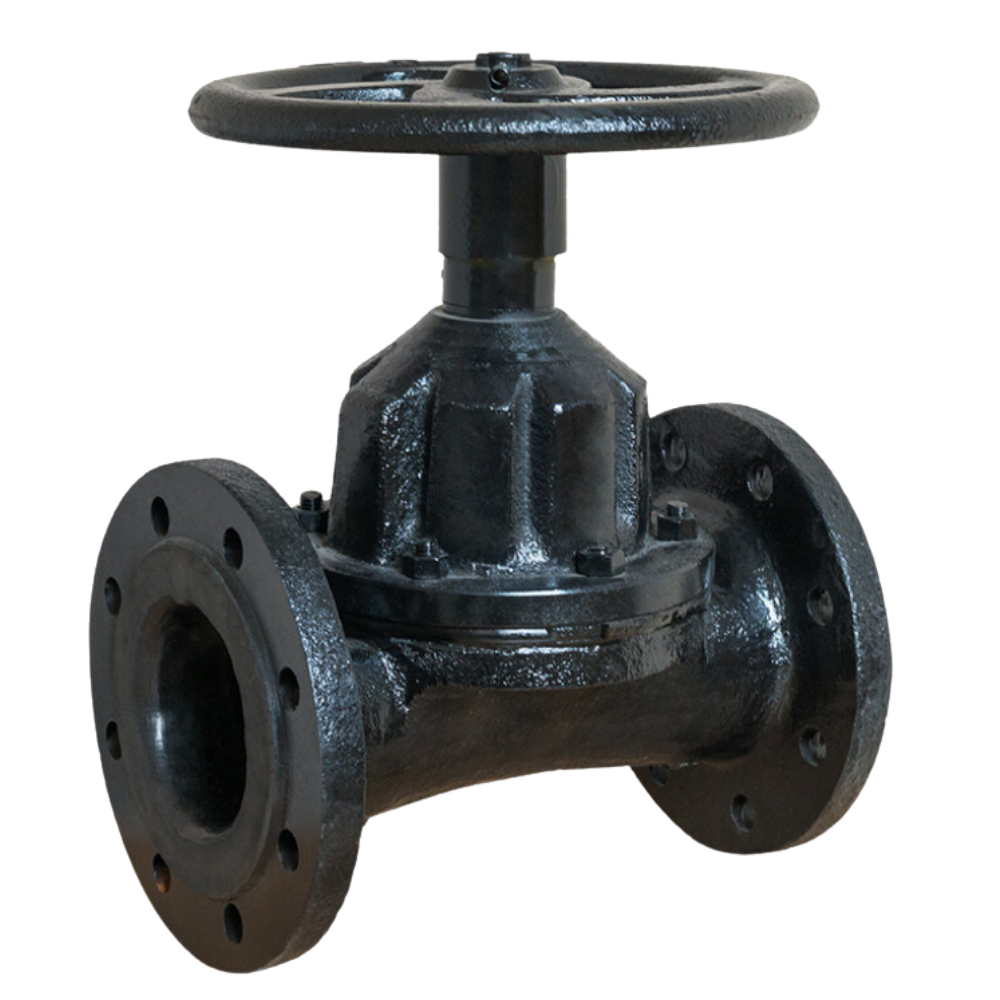




A fluorine-lined gate valve controls the flow of corrosive fluids in industries like chemical processing and water treatment. The internal surfaces are coated with a fluorine lining, providing resistance to chemical corrosion.
The valve operates by raising or lowering a gate to start or stop fluid flow. When fully open, it allows fluid to pass through with minimal pressure drop. This design is suitable for on-off applications, ensuring the medium is isolated without contact with internal components.
| Name/Material | WCB | CF8 | CF3 | CF8M | CF3M |
| Body | WCB | CF8 | CF3 | CF8M | CF3M |
| Stem | WCB | CF8 | CF3 | CF8M | CF3M |
| Plug | WCB | CF8 | CF3 | CF8M | CF3M |
| Lined | FEP / PFA / PO / PTFE | ||||
| Seat | PTFE / RPTFE | ||||
| Bolt/Nut | B7/2H | B8/8 | B8/8 | B8M/8M | B8M/8M |
| Design&Manufacture Standard | GB/T12234 | API 6D | ||
| FTF Dimension Standard | HG/T3704, GB/T12221 | ASME B16.10 | ||
| Flange standard | HG/T20592, GB/T9119 | ASME B16.5, JIS B2220 | ||
| Inspection & Test Standard | HG/T13927, JB/T9092 | API 598 | ||
| Normal Diameter | DN15~DN350 | 1/2”~14” | ||
| Normal Pressure | 1.0MPa | 1.6MPa | 150LB | |
| Test pressure | Shell Test | 1.5MPa | 1.5MPa | 1.5MPa |
| High Pressure Test | 1.1MPa | 1.1MPa | 1.1MPa | |
| Low Pressure Test | 0.6MPa | 0.6MPa | 0.6MPa | |
| Temperature Range | FEP:-29℃~120℃, PFA:-29℃~180℃, PTFE:-29℃~150℃ | |||
| Applicable Medium | Strong corrosion medium: Hydrochloric acid, Nitric acid, Hydrofluoric acid, Liquid chlorine, Sulfuric acid and Aqua regia etc. | |||


| DN (mm | PNS (Inch) | L | D | D1 | D2 | f | b | Z-Φd | H |
| 25 | 1 | 160 | 115 | 85 | 65 | 3 | 17 | 4-14 | 230 |
| 32 | 1-1/4 | 180 | 140 | 100 | 75 | 3 | 19 | 4-18 | 245 |
| 40 | 1-1/2 | 240 | 150 | 110 | 85 | 3 | 19 | 4-18 | 285 |
| 50 | 2 | 250 | 165 | 125 | 100 | 3 | 21 | 4-18 | 300 |
| 65 | 2-1/2 | 270 | 185 | 145 | 120 | 3 | 21 | 4-18 | 340 |
| 80 | 3 | 280 | 200 | 160 | 135 | 3 | 21 | 8-18 | 410 |
| 100 | 4 | 300 | 220 | 180 | 155 | 3 | 23 | 8-18 | 465 |
| 125 | 5 | 325 | 250 | 210 | 185 | 4 | 24 | 8-18 | 620 |
| 150 | 6 | 350 | 285 | 240 | 210 | 4 | 26 | 8-23 | 710 |
| 200 | 8 | 400 | 340 | 295 | 265 | 4 | 26 | 8/12-23 | 780 |
| 250 | 10 | 450 | 395 | 350 | 320 | 4 | 28 | 12-23/26 | 1000 |
Fluorine-lined gate valve is a kind of valve. The opening and closing part of the fluorine-lined gate valve is the gate plate. The direction of movement of the gate plate is perpendicular to the direction of the fluid. The gate valve can only be fully opened and fully closed, not adjusted and throttled. The gate has two sealing surfaces. The most commonly used mode is that the two sealing surfaces of the gate valve form a wedge shape. The wedge angle varies with the valve parameters.
The fluorine lining protects the valve from corrosive chemicals, making it suitable for harsh environments and aggressive fluids.
The lining enhances the durability of the valve, reducing wear and increasing longevity, even in challenging applications.
Fluorine-lined gate valves perform well in a range of temperatures, ensuring reliable operation in both high and low-temperature environments.
The fluorine lining prevents the fluid from reacting with the valve body, ensuring purity in sensitive processes.
The smooth internal lining reduces friction, allowing for easier operation and reduced wear on the valve components over time.

A weir-type diaphragm valve is a specific design of diaphragm valve that features a raised lip or saddle in the valve body. The diaphragm comes into contact with this weir to form a seal and control fluid flow. Main parts and materials Name/Material CI WCB CF8 CF3 CF8M CF3M Body CI WCB CF8 CF3 CF8M CF3M Diaphragm […]

A straight-through diaphragm valve controls fluid flow in a pipeline using a diaphragm that moves vertically to open or close the flow path. The straight-through design allows fluid to pass directly through the valve, reducing pressure drop and maintaining efficient flow. It is commonly used in applications where reliable sealing and minimal obstruction are needed, […]

A plug valve controls fluid flow in a pipeline using a cylindrical or tapered plug with a central hole. The plug rotates within the valve body to open or close the flow path. When the plug aligns with the pipeline, fluid passes through. When turned so the hole is perpendicular to the flow, it blocks […]

A fluorine lined control valve regulates the flow of fluids in a pipeline, adjusting flow rate, pressure, and temperature. It works by changing the size of the flow passage using elements like plugs, balls, or diaphragms. Control valves are crucial in industrial processes for maintaining operating conditions and ensuring system efficiency. They can be operated […]